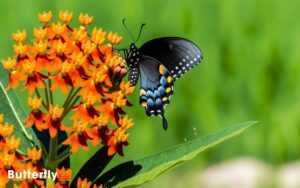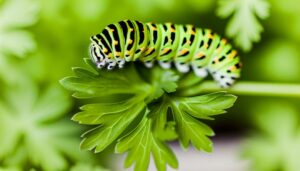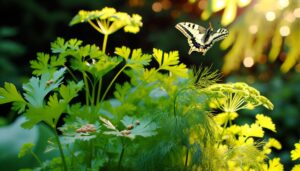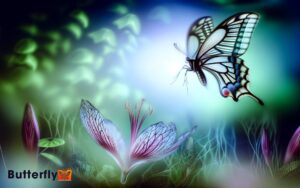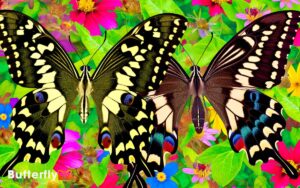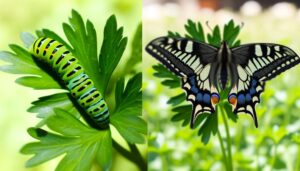Black Swallowtail Butterflies South Carolina: Explain!
Black Swallowtail Butterflies (Papilio polyxenes) thrive in South Carolina’s hot summers and mild winters. Recognizable by their black wings with yellow spots and blue crescents, females have larger blue areas on their hindwings.
They undergo complete metamorphosis from egg to adult, relying on host plants like parsley and fennel for larval nourishment.
Adults feed on nectar-rich flowers such as milkweed and thistle. Observers can find them in coastal marshes and botanical gardens.
These pollinators play an essential role in maintaining ecological balance. Understanding their behavior and habitat preferences can reveal more about their significance in South Carolina.
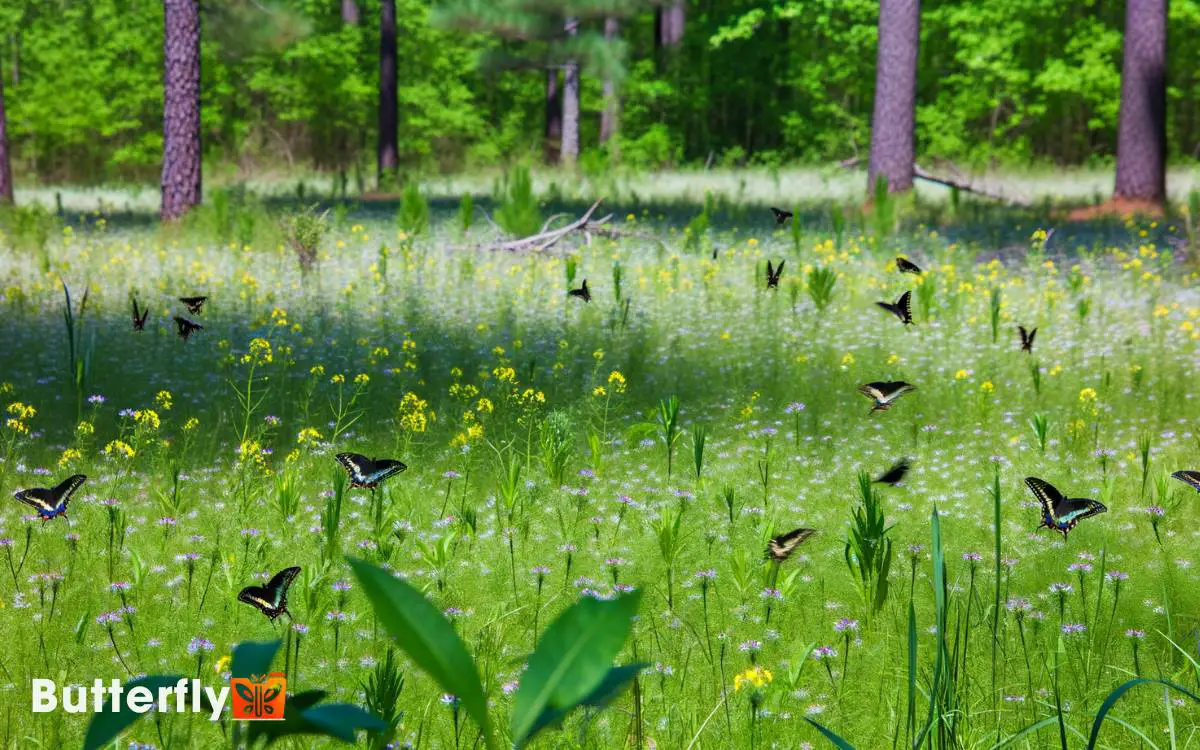
Key Takeaways
Description and Identification
The Black Swallowtail butterfly, scientifically known as Papilio polyxenes, displays noticeable physical characteristics that facilitate its identification, such as its mainly black wings adorned with yellow spots and a unique double row of blue crescents on the hindwings.
The forewings span between 8.0 and 11.0 centimeters, showcasing an intricate pattern that contrasts sharply with the black background.
Sexual dimorphism is evident; females exhibit larger blue areas on the hindwings compared to males. The ventral side features a muted palette with lighter grayish-brown tones and a series of orange spots near the margins.
These distinct markings not only aid in identification but also play a role in camouflage and predator deterrence, providing the butterfly with an evolutionary advantage in its natural habitat.
Life Cycle Stages
Black Swallowtail butterflies undergo a complete metamorphosis, progressing through distinct stages that include egg, larva, pupa, and adult.
Females lay eggs on host plants such as parsley and fennel. The eggs hatch into larvae, commonly known as caterpillars, which voraciously consume leaves to fuel rapid growth.
The larval stage features five instars, each marked by molting. Upon reaching full size, the caterpillar forms a chrysalis, entering the pupal stage. During this phase, dramatic cellular reorganization occurs, transforming the caterpillar into an adult butterfly.
This transformation, known as metamorphosis, is essential for the butterfly’s developmental process. Once metamorphosis is complete, the adult emerges, ready to reproduce and continue the life cycle, embodying the essence of transformation and freedom.
Natural Habitat
The natural habitat of Black Swallowtail butterflies in South Carolina is influenced by their reliance on specific host plants like parsley and fennel.
The region’s temperate climate and variable weather patterns play an essential role in their distribution and activity.
Predation and other environmental threats further impact their survival, shaping their ecological presence.
Preferred Host Plants
Due to their specific dietary requirements, black swallowtail butterflies in South Carolina mainly lay their eggs on host plants such as parsley, dill, fennel, and various species of the carrot family, which provide essential nutrients for the larvae.
These plants, rich in essential oils and secondary metabolites, offer a conducive environment for larval growth and development.
Caterpillars exhibit a marked preference for these hosts, leveraging their bioactive compounds to enhance survival rates and deter predators.
The strategic selection of these plants guarantees that larvae have immediate access to crucial resources, optimizing their metabolic and physiological processes.
Consequently, the presence of these host plants directly influences the distribution and population dynamics of black swallowtail butterflies in the region.
Climate and Weather
South Carolina’s subtropical climate, characterized by hot summers and mild winters, creates an ideal habitat for black swallowtail butterflies, influencing their life cycles and behavior patterns.
High temperatures accelerate metabolic rates, leading to quicker development from larva to adult.
Mild winters allow for multiple generations per year, enhancing population stability. Consistent humidity levels maintain the health of host plants, ensuring a steady food supply for larvae.
Rainfall patterns also play an important role; adequate precipitation supports lush vegetation, while drought can disrupt the availability of essential resources.
Diurnal temperature variations influence flight activity, with butterflies favoring mid-morning and late afternoon. Therefore, South Carolina’s climate intricately supports the thriving existence of black swallowtail butterflies, driving their ecological success.
Predators and Threats
In spite of South Carolina’s supportive climate, black swallowtail butterflies face numerous predators and threats that greatly impact their populations.
Predation from birds, spiders, and wasps greatly reduces their numbers. Additionally, habitat loss due to urbanization and pesticide use poses severe risks. The intricate interplay between these factors creates a challenging environment for survival.
| Predator | Impact on Population | Mitigation Strategies |
|---|---|---|
| Birds | High predation rates | Promoting bird-safe zones |
| Spiders | Moderate predation | Habitat management |
| Wasps | Larval predation | Natural repellents |
| Urbanization | Habitat loss | Conservation efforts |
| Pesticides | Toxicity and mortality | Organic farming practices |
Understanding these threats is essential for developing effective conservation strategies.
Feeding Habits
Black Swallowtail butterflies exhibit a preference for nectar from a variety of flowering plants, including milkweed, phlox, and thistle.
This diverse diet supports their energy needs for flight and reproduction. Using their proboscis, they extract nectar efficiently, favoring flowers with easily accessible nectar.
Their feeding behavior is driven by the availability of these plants, which vary with seasonal and regional changes in South Carolina.
Larvae, or caterpillars, have distinct feeding habits, primarily consuming plants in the Apiaceae family, such as parsley, dill, and fennel. This herbivory is essential for their growth and metamorphosis.
Understanding these feeding habits provides insights into their survival strategies and ecological requirements, highlighting the importance of plant diversity in their habitats.
Role in Ecosystem
These butterflies serve as essential pollinators, facilitating the reproduction of various flowering plants and maintaining ecological balance.
Black Swallowtail butterflies contribute immensely to the pollination of native flora, including species such as milkweed, thistles, and wild carrots. Their interaction with these plants enhances genetic diversity and aids in seed production, vital for ecosystem resilience.
Additionally, their larvae, which primarily feed on Apiaceae family plants, play a role in controlling plant populations, preventing any single species from dominating. This dynamic fosters a balanced ecosystem, supporting a wide range of organisms.
Seasonal Behavior
Black Swallowtail butterflies in South Carolina exhibit distinct seasonal behaviors. Researchers have documented that these butterflies generally migrate northward in the spring and southward in the fall, aligning with temperature changes and host plant availability.
Breeding activity typically peaks during the warm months, with multiple generations observed between late spring and early fall.
Migration Patterns Observed
Throughout South Carolina, researchers have meticulously documented the distinct seasonal migration patterns of Black Swallowtail butterflies. They have noted significant variations in their behavior and movement across different times of the year.
In spring, these butterflies emerge from pupae and begin their northward journey. They are driven by rising temperatures and blooming flora.
Summer sees a dispersal phase for the butterflies. During this time, they establish territories and forage extensively.
By late summer to early autumn, a southward migration initiates as the butterflies seek warmer climates to guarantee survival.
This cyclical pattern is influenced by environmental cues such as daylight length and temperature changes. These triggers hormonal responses that regulate their migratory behavior.
Understanding these patterns provides valuable insights into their adaptability and ecological interactions within South Carolina’s diverse habitats.
Breeding Season Insights
Researchers frequently observe that the breeding season of Black Swallowtail butterflies in South Carolina is marked by intricate courtship behaviors and precise oviposition strategies tailored to the region’s flowering plants.
Males engage in aerial displays to attract females, showcasing agility and stamina. Females, once receptive, seek specific host plants for egg-laying, ensuring larval food sources.
The following behaviors are commonly documented:
- Aerial courtship displays: Males perform dynamic flights to demonstrate fitness.
- Host plant selection: Females identify suitable flora such as dill and parsley.
- Egg-laying precision: Eggs are deposited strategically on tender leaves.
- Nectar feeding: Both sexes frequent nectar-rich flowers to sustain energy.
These behaviors underscore the butterfly’s adaptation to South Carolina’s unique ecosystem.
Best Observation Spots
For enthusiasts aiming to observe Black Swallowtail butterflies in South Carolina, the coastal marshes and inland botanical gardens provide ideal habitats due to their diverse flora and microclimates. These areas support a variety of host plants, such as parsley and dill, which are crucial for caterpillar development. Observers may also spot the eastern black swallowtail in Blacksburg, especially in gardens that cultivate nectar-rich flowers. Seasonal changes influence their activity, with peak sightings occurring in the warm months of spring and summer.
Coastal marshes, such as those in the Santee Coastal Reserve, offer a variety of nectar sources and host plants essential for the butterflies’ lifecycle.
Inland, Riverbanks Zoo and Garden in Columbia boasts meticulously curated plantings that attract and sustain these butterflies. The varied microclimates in these locations create excellent conditions for mating, feeding, and egg-laying.
Observers should focus on areas with abundant parsley, fennel, and dill, which are primary host plants. Early morning and late afternoon provide the best lighting for sightings and photography, maximizing the chance to witness their vibrant displays.
Conservation Efforts
Recognizing the importance of these habitats for the Black Swallowtail butterfly, South Carolina has implemented several conservation initiatives aimed at preserving and restoring native plant species critical to the butterfly’s lifecycle.
These efforts focus on:
- Habitat Restoration: Projects that reintroduce native flora, such as Queen Anne’s Lace and parsley, to provide essential food sources for larvae.
- Pollinator Gardens: Establishing community gardens to support a diverse ecosystem that benefits butterflies.
- Education Programs: Initiatives that educate the public on the significance of native plants and butterfly conservation.
- Regulatory Measures: Enforcing policies that limit pesticide use and protect butterfly habitats from urban development.
These targeted actions are essential for maintaining the butterfly’s population and ensuring ecological balance in South Carolina.
Gardening for Black Swallowtails
Creating a garden that attracts and supports Black Swallowtail butterflies involves carefully selecting and cultivating native host and nectar plants.
This guarantees a thriving habitat for both larvae and adult butterflies. Key host plants include fennel, parsley, and dill, essential for caterpillar development. Nectar plants such as milkweed, zinnias, and coneflowers provide essential sustenance for adult butterflies.
Gardeners should plant in sunny, sheltered areas to protect butterflies from wind and predators. Avoiding pesticides is essential to prevent harming these delicate insects.
Implementing a layered planting strategy, with taller plants providing cover and shorter ones offering feeding opportunities, maximizes habitat efficiency.
Regular maintenance, including pruning and monitoring for pests, ensures long-term garden health and butterfly attraction.
Conclusion
Just as a painter’s brush brings a blank canvas to life with vibrant strokes, the black swallowtail butterfly graces South Carolina’s landscapes with its vivid presence.
Through each life stage, from egg to adult, it plays an essential role in the ecosystem, pollinating flowers and supporting biodiversity.
Observing these delicate creatures in their natural habitats, and nurturing gardens tailored for them, guarantees their survival. This delicate dance of nature underscores the intricate tapestry of life in South Carolina.

